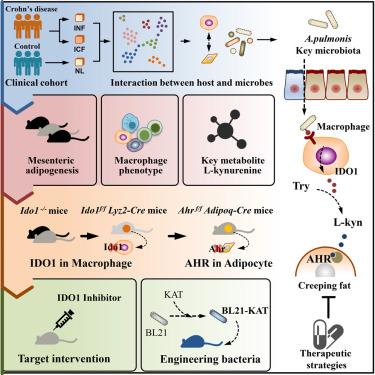当前位置:
X-MOL 学术
›
Cell Host Microbe
›
论文详情
Our official English website, www.x-mol.net, welcomes your
feedback! (Note: you will need to create a separate account there.)
Microbiota-induced alteration of kynurenine metabolism in macrophages drives formation of creeping fat in Crohn’s disease
Cell Host & Microbe ( IF 20.6 ) Pub Date : 2024-11-13 , DOI: 10.1016/j.chom.2024.10.008 Jinjie Wu, Wanyi Zeng, Hongyu Xie, Mujia Cao, Jingyi Yang, Yanchun Xie, Zhanhao Luo, Zongjin Zhang, Haoyang Xu, Weidong Huang, Tingyue Zhou, Jinyu Tan, Xiaomin Wu, Zihuan Yang, Shu Zhu, Ren Mao, Zhen He, Ping Lan
Cell Host & Microbe ( IF 20.6 ) Pub Date : 2024-11-13 , DOI: 10.1016/j.chom.2024.10.008 Jinjie Wu, Wanyi Zeng, Hongyu Xie, Mujia Cao, Jingyi Yang, Yanchun Xie, Zhanhao Luo, Zongjin Zhang, Haoyang Xu, Weidong Huang, Tingyue Zhou, Jinyu Tan, Xiaomin Wu, Zihuan Yang, Shu Zhu, Ren Mao, Zhen He, Ping Lan

|
Hyperplasia of mesenteric tissues in Crohn’s disease, called creeping fat (CrF), is associated with surgical recurrence. Although microbiota translocation and colonization have been found in CrF, convincing mouse phenotypes and the underlying mechanisms of CrF formation remain unclear. Utilizing single-nucleus RNA (snRNA) sequencing of CrF and different mouse models, we demonstrate that the commensal Achromobacter pulmonis induces mesenteric adipogenesis through macrophage alteration. Targeted metabolome analysis reveals that L-kynurenine is the most enriched metabolite in CrF. Upregulation of indoleamine 2,3-dioxygenase 1 (IDO1) enhances kynurenine metabolism and drives mesenteric adipogenesis. Leveraging single-cell RNA (scRNA) sequencing of mouse mesenteric tissues and macrophage-specific IDO1 knockout mice, we verify the role of macrophage-sourced L-kynurenine in mesenteric adipogenesis. Mechanistically, L-kynurenine-induced adipogenesis is mediated by the aryl hydrocarbon receptors in adipocytes. Administration of an IDO1 inhibitor or bacteria engineered to degrade L-kynurenine alleviates mesenteric adipogenesis in mice. Collectively, our study demonstrates that microbiota-induced modulation of macrophage metabolism potentiates CrF formation.
中文翻译:

微生物群诱导的巨噬细胞犬尿氨酸代谢的改变推动了克罗恩病中蠕动脂肪的形成
克罗恩病中肠系膜组织增生,称为匍匐脂肪 (CrF),与手术复发有关。尽管在 CrF 中发现了微生物群易位和定植,但令人信服的小鼠表型和 CrF 形成的潜在机制仍不清楚。利用 CrF 和不同小鼠模型的单核 RNA (snRNA) 测序,我们证明共生肺无色杆菌通过巨噬细胞改变诱导肠系膜脂肪生成。靶向代谢组分析显示,L-犬尿氨酸是 CrF 中最富集的代谢物。吲哚胺 2,3-双加氧酶 1 (IDO1) 的上调增强了犬尿氨酸代谢并驱动肠系膜脂肪生成。利用小鼠肠系膜组织和巨噬细胞特异性 IDO1 敲除小鼠的单细胞 RNA (scRNA) 测序,我们验证了巨噬细胞来源的 L-犬尿氨酸在肠系膜脂肪生成中的作用。从机制上讲,L-犬尿氨酸诱导的脂肪生成是由脂肪细胞中的芳烃受体介导的。施用 IDO1 抑制剂或工程改造以降解 L-犬尿氨酸的细菌可减轻小鼠肠系膜脂肪生成。总的来说,我们的研究表明,微生物群诱导的巨噬细胞代谢调节会增强 CrF 的形成。
更新日期:2024-11-13
中文翻译:

微生物群诱导的巨噬细胞犬尿氨酸代谢的改变推动了克罗恩病中蠕动脂肪的形成
克罗恩病中肠系膜组织增生,称为匍匐脂肪 (CrF),与手术复发有关。尽管在 CrF 中发现了微生物群易位和定植,但令人信服的小鼠表型和 CrF 形成的潜在机制仍不清楚。利用 CrF 和不同小鼠模型的单核 RNA (snRNA) 测序,我们证明共生肺无色杆菌通过巨噬细胞改变诱导肠系膜脂肪生成。靶向代谢组分析显示,L-犬尿氨酸是 CrF 中最富集的代谢物。吲哚胺 2,3-双加氧酶 1 (IDO1) 的上调增强了犬尿氨酸代谢并驱动肠系膜脂肪生成。利用小鼠肠系膜组织和巨噬细胞特异性 IDO1 敲除小鼠的单细胞 RNA (scRNA) 测序,我们验证了巨噬细胞来源的 L-犬尿氨酸在肠系膜脂肪生成中的作用。从机制上讲,L-犬尿氨酸诱导的脂肪生成是由脂肪细胞中的芳烃受体介导的。施用 IDO1 抑制剂或工程改造以降解 L-犬尿氨酸的细菌可减轻小鼠肠系膜脂肪生成。总的来说,我们的研究表明,微生物群诱导的巨噬细胞代谢调节会增强 CrF 的形成。






























 京公网安备 11010802027423号
京公网安备 11010802027423号